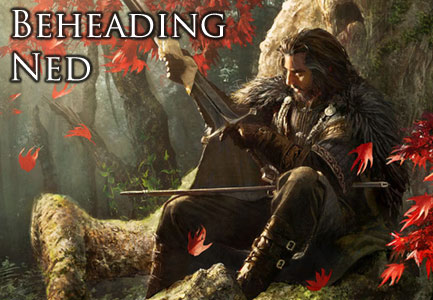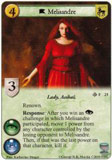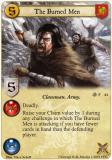Welcome to Card Game DB
Register now to gain access to all of our features. Once registered and logged in, you will be able to create topics, post replies to existing threads, give reputation to your fellow members, get your own private messenger, post status updates, manage your profile and so much more. If you already have an account, login here - otherwise create an account for free today!
Register now to gain access to all of our features. Once registered and logged in, you will be able to create topics, post replies to existing threads, give reputation to your fellow members, get your own private messenger, post status updates, manage your profile and so much more. If you already have an account, login here - otherwise create an account for free today!
Beheading Ned - The Brotherhood Without Banners
May 16 2012 05:00 AM |
mathiasfricot
in Game of Thrones
Small Council Beheading Ned mathiasfricot “Any knight can make a knight,†said the scarecrow that was Beric Dondarrion, “and every man you see before you has felt a sword upon his shoulder. We are the forgotten fellowship.†– Lord Beric Dondarrion
“Any knight can make a knight,†said the scarecrow that was Beric Dondarrion, “and every man you see before you has felt a sword upon his shoulder. We are the forgotten fellowship.†– Lord Beric DondarrionWelcome back again to Beheading Ned, a column about A Game of Thrones: The Card Game emphasizing the thematic side of the game. For newer readers less acquainted with CardgameDB’s Small Council Initiative, this column will be spending less energy dedicated to interesting card interactions, dubbed the ‘Shagga’ side of the game, or what is the most efficient way to win, dubbed the ‘Jaime’ side of the game. For more detail on these main player archetypes you can take a look at my first article, found here and look at All Things Shagga or The Things I Do For Win, columns put together by Kennon and clu respectively.
This week I am going to stray from my usual deck building and look at a particular chapter pack cycle; the Brotherhood Without Banners. This cycle resonates with me, as it was the first cycle to hit the shelves when I began playing, and is a great place to start for new players offering a tribal deck for each house built around a particular trait that you can use to accompany the Core Set. It also has a ton of thematic material to work with. I will be looking at the Baratheon, Stark, Lannister, and Neutral house-specific traits developed over the cycle and what I consider the best, or funnest, cards within them. Naturally, if I am talking about theme I am going to be talking about the books, so spoilers are a certainty going forward.
House Baratheon – Soldiers of the Lord of Light
The Asshai theme out of Baratheon is polarized. Mechanically, I find it fits very well with what the designers were trying to represent. Overall, I think it is the least thematic of the traits developed over these six chapter packs. I really enjoy playing with them, an early Alter of Fire can be devastating and the Fanatic attachment is really well done, don’t get me wrong – an intrigue oriented theme tapping into black magic and mischief if more than fun. The problem I have with the mechanics around Asshai characters is that House Baratheon doesn’t actually have very many Asshai supporters. I think the mechanics, the art, the names, would all have been better suited to the House Florent trait, or something new like Queen’s Men. Wicked Seductress, Intolerant Priest, Shadow Enchantress, Bound By the Light; their mechanics fit the designer’s intent – the movement within Stannis’ troupe towards the R’hllor, the Lord of Light, and all the power and peril that goes along with it. I would just have preferred it was something other than the Asshai trait tied into these mechanics, because to me it just doesn’t fit.
Altar of Fire.
They were all afire now, Maid and Mother, Warrior and Smith, the Crone with her pearl eyes and the Father with his gilded beard; even the Stranger, carved to look more animal than human. The old dry wood and countless layers of paint and varnish blazed with a fierce hungry light. Heat rose shimmering through the chill air; behind, the gargoyles and stone dragons on the castle walls seemed blurred, as if Davos were seeing them through a veil of tears. Or as if the beasts were trembling, stirring...
Altar of Fire (RoR) is a powerful location; you get to see your opponent’s hand and remove the greatest threat. This ability really fits with the ability of Melisandre to see the future in her flames (although her interpretation of what she sees has not been perfect). The artwork depicts the burning of the idols of the Seven on Dragonstone, the fire from where Stannis pulled Lightbringer. The only thing keeping this card from being perfect is it’s trait – Storm’s End should be Dragonstone. Still, a great card thematically and one that flows with the mechanics built into the Asshai theme over this cycle.
Melisandre – The Red Woman.
His hands had not been so steady for years, nor half so fluid. Davos saw, but no one else, he was certain. Cup in hand, he rose to his feet. “Mayhaps I have been a fool. Lady Melisandre, will you share a cup of wine with me? A cup in honor of your god, your Lord of Light? A cup to toast his power? “
The red woman studied him. “If you wish.â€
This version of Melisandre (RoR) is as good as it gets from a thematic perspective. We first see her character introduced from the perspective of Maester Cressen (Core) in the prologue for A Clash of Kings (and in the HBO series season 2 episode “The North Remembers.†We see Cressen as Stannis’ ailing advisor, advising the King to join with the cause of Robb Stark against the Lannisters. When Stannis instead puts his trust in R’hllor, Cressen blames the red witch and plans to kill her by poisoning her. Sensing the danger, Melisandre suggests he throw the wine away, while Cressen insists they share the cup. Melisandre is unaffected and Cressen dies from the poison. I would be hard pressed to find a better way to capture this moment through a character ability than what she has here - the ability to steal a power from a character after a successful intrigue challenge (ie. poisoned wine) and kill them if it was their last power (ie. Cressen).
Neutral – The Brotherhood Without Banners
The cycle’s namesake, the Brotherhood Without Banners is embodied in their namesake agenda. From a thematic perspective the strong showing of unique characters is a surefire way to get me buying pack after pack. Mechanically, FFG did a phenomenal job of building a way to capture this group of beggars and outlaws. They don’t support a particular house during the War of Five Kings, with the agenda their success doesn’t see power being moved to the house card. Their strength is rooted in the support of the smallfolk throughout the Riverlands, built entirely on their reputation – their power lies in their individual characters, mechanically and thematically. Losing a member of the Brotherhood hurts them more than losing someone like Kyle Condon or The Red Viper, everything that Lem Lemoncloack built up is lost when he leaves play and you lose the power on him, the smallfolk lose that person to gather around.
Thoros of Myr.
“Thoros, how many times have you brought me back now?â€
The red priest bowed his head. “It is R’hllor who brings you back, my lord. The Lord of Light. I am only his instrument.â€
“How many times?†Lord Beric insisted.
“Six,†Thoros said reluctantly. “And each time is harder.â€
The red priest of R’hllor accidentally resurrected Beric Dondarrion when performing a ritual of his faith. A founding member of the Brotherhood Without Banners, having a unique copy of Thoros of Myr (RoR) is expected. His ability to save from death is rightly fitting, but the cost of losing power is what makes this exceptionally thematic – every time Beric Dondarrion was revived he lost more and more of his memory, reflected here when he loses more and more of his power each time a Brotherhood character is saved.
Gossip and Lies.
I really like this card: usually I have it as a x2 in my Brotherhood decks. Gossip and Lies (OSaS) helps you push that important challenge over the top. The strength of the Brotherhood without Banners lies is in the support of the smallfolk, just like the Kingswood Brotherhood before it. This support is inspired by misinformation, propaganda, fear, hope, gossip and lies. Is Beric dead? Where is he? Who is the Brotherhood?
Beric Dondarrion, The Lightning Lord.
Unsmiling, Lord Beric laid the edge of his longsword against the palm of his left hand, and drew it slowly down. Blood ran dark from the gash he made, and washed over the steel.
And then the sword took fire.
The king of theme in this cycle, Beric Dondarrion (IG) is our unkillable leader of the knights of the hollow hill, made more powerful than ever when you equip him with his flaming sword. Separate from the War of Five Kings plaguing the Riverlands, Lord Dondarrion favours no particular house in the struggle for the iron throne. His goal is the protection of the smallfolk vandalized by the Stark and Lannister forces both. Like most other Brotherhood characters, as soon as you have power on your house he is deactivated; just another killable, discardable renown Knight. As soon as power moves to your house card, you’ve forsaken the purity of his cause, and Beric becomes mortal once more.
House Stark – The Boltons
The Boltons are a group of northerners you love to hate. Led by Roose Bolton out of his seat at the Dreadfort, this batch of scoundrels left a trail of red across the white snows of the north. Their most notorious quality is their willingness to change sides as fast as the winds shift. The Bolton theme built over these few chapter packs is incredibly fun to play, some of the most fun I have had playing this game in the joust format was with a Bolton deck – you have to balance the challenges you make offensively and defensively to try and keep yourself from losing too many of these fickle followers. True story, I was once playing in a game where I lost a power challenge as the defender when my opponent had revealed Valar and I used Narrow Escape. The board position was such that I had about 4-5 characters, and he had one or two weenies. My opponent took my Flayed Men, used it to win a subsequent claim zero military challenge (so I could not sacrifice my Bastard’s Elite to claim), which he used to win dominance and take Steelshanks Walton. Things went downhill from there. All from a claim zero power challenge. With the slightest sign the tides are turning, those Boltons really jump ship fast.
The Flayed Men (DB) / The Bastard's Elite (RoR) / Bolton Loyalist (DB).
The whole Bolton theme is developed really well in this cycle, so I have grouped these three unique characters together. They each have a passive ability that changes their controller if you lose a different kind of challenge. It is elegant, it is simple, and it is thematic.
Reek / The Bastard of Bolton.
Reek (MotM), Ramsay Bolton, Theon Greyjoy all use this alias throughout the novels. Which character this alias refers to isn’t clear (In the LCG we have seen Stoneheart and Catelyn, Arstan and Barristan Selmy, Tyrion and Hugor Hill). I like to think it is the “original†Reek, where he switched places with Ramsay Bolton and was inadvertently killed by the men of Rodrik Cassel. This is almost exactly what happens when you use Reek in-game: you win an intrigue challenge with him, you trade characters with an opponent, and then he is usually lost for claim on a military challenge. I have grouped his inseparable friend Ramsay (The Bastard of Bolton (IG)) with him, because Ramsay jumps in when a character changes sides – something you see a lot of with the Bolton mechanics – because of that instance when Ramsay pretended to be Reek to escape Rodrik Cassel, and pretended to ally with Ser Rodrik before turning his cloak and revealing his identity. Oh the flavour.
Roose Bolton.
"Roose has no feelings, you see. Those leeches that he loves so well sucked all the passions out of him years ago. He does not love, he does not hate, he does not grieve. This is a game to him, mildly diverting. Some men hunt, some hawk, some tumble dice. Roose plays with men. You and me, these Freys, Lord Manderly, his plump new wife, even his bastard, we are but his playthings."
The Leech Lord’s ability to keep all his followers in line is impeccable. I’ve heard many people compare his persona to Tywin Lannister; they are ruthless, efficient and calculating leaders. The difference I see is that the followers Tywin has are inspired by him, the followers Roose Bolton (DB) has exist in perpetual fear of him, and this is how he keeps them in line. When he successfully partakes in an intrigue challenge, all those Boltons you just lost come clamoring back to Roose. Nobody else could keep them in line; they are not honourable men motivated by duty. These are men motivated by self preservation, something Roose is more than attuned to use to his advantage. He weaves a much more complicated net than a man like Eddard Stark when keeping followers in line. The fact that he doesn’t kneel to attack on Intrigue challenges really emphasizes how adept at the game of thrones Roose Bolton really is.
House Lannister – The Mountain Clans
Who doesn’t enjoy a casual game with some clansmen? Tyrion’s unruly group of mountain men are great – they come in fast, go on high claim challenges, and promote a all-or-nothing offensive kind of play that is traditionally not seen in House Lannister.
The clansmen are groups of tribes, big and small, living in the Mountains of the Moon that border the Vale. These people live independent from the Seven Kingdoms, the rule of Eyrie or the Iron Throne. Some clans, notably the Stone Crows, Milk Snakes, Black Ears and the Burned Men, decide to follow Tyrion Lannister in exchange for the rewards he could give them – arms and armor, payment, and the potential revenge on the Eyrie.
This mechanic was frowned upon by a lot of players because it rewards you for being in a disadvantaged position – having fewer cards in your hand. That is something you generally do not want to do. While Painted Dogs (IG) (the clansman Tyrion brought with him to Kings Landing and, if I remember correctly, had serve as Goldcloaks) see some competitive play for the gold slot, icon distribution, and ability they sometimes have, most other clansman are less than ideal because without their abilities they are just chuds that are less than par with a Knight of the Tumblestone. The counter? Clansman are super fun to play with. Really, really, fun. That is one of the things I liked to much about this cycle; we got a huge benefit to casual play, and that is the void clansman were trying to fill.
Hidden Vale Pass.
I’m tired, so forgive me for including only one Lannister card to focus on. Hidden Vale Pass (MotM) is one of the locations in the game that is a shining star on the casual circuit but will probably never push its way into the successful competitive environment. From a thematic point, nobody knows the Mountains of the Moon like the clansmen. It is their turf, and their ability to ambush any travelers here cannot be matched. It is the home field advantage. No amount of planning can guarantee protection from their raids. You use this location jump in a character to win a challenge offensively and has theme written all over it. If your doing it in the right context, throwing in a copy of The Burned Men can increase your claim, and getting rid of a card from your hand can activate the other clansman abilities like Tyrion’s Enforcers or Tribes of the Vale. The problem with this location is that in the long term you are just trading one card from your hand for one card of your opponents, whereas playing that character will give you repeated use. Short term massive boon, long term bust.
But hey, it isn’t like the clansman think long term anyway.
- sparty likes this



 Sign In
Sign In Create Account
Create Account














4 Comments
Well, how would you write an article about Nedliness without spoilers?
My comment wasn't meant to be negative feedback but just a rant to myself for not having read the books yet, even though I want to (lazy)